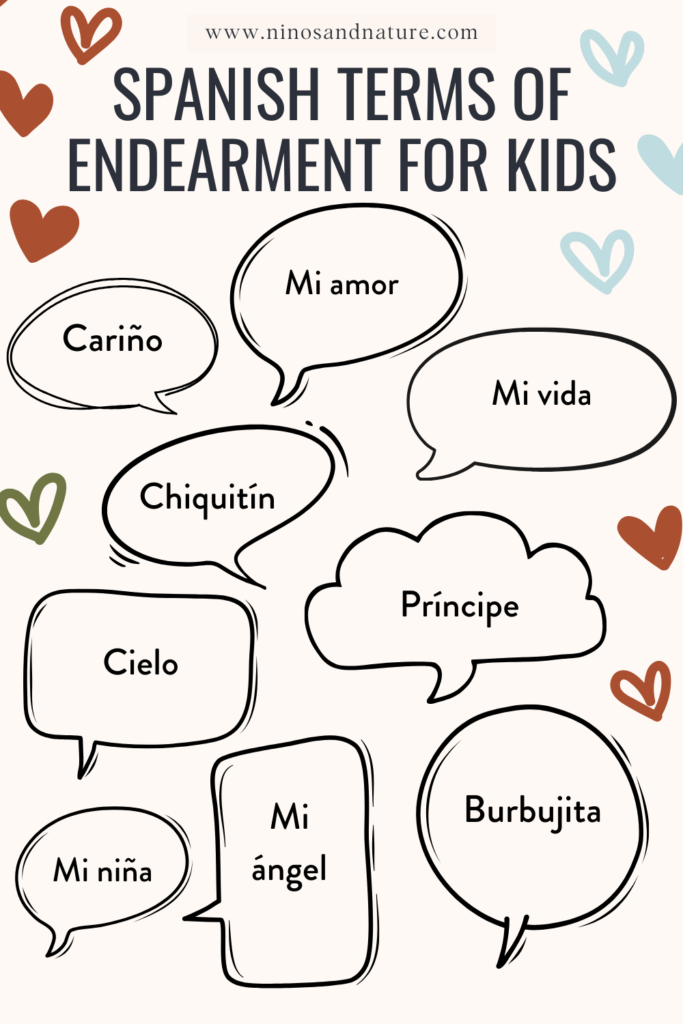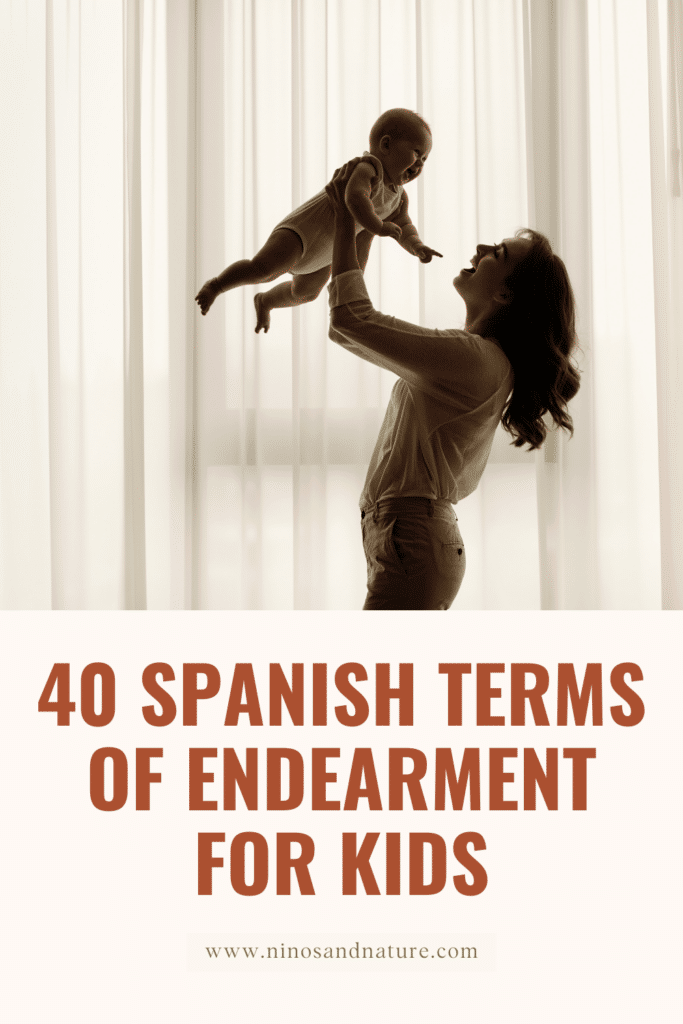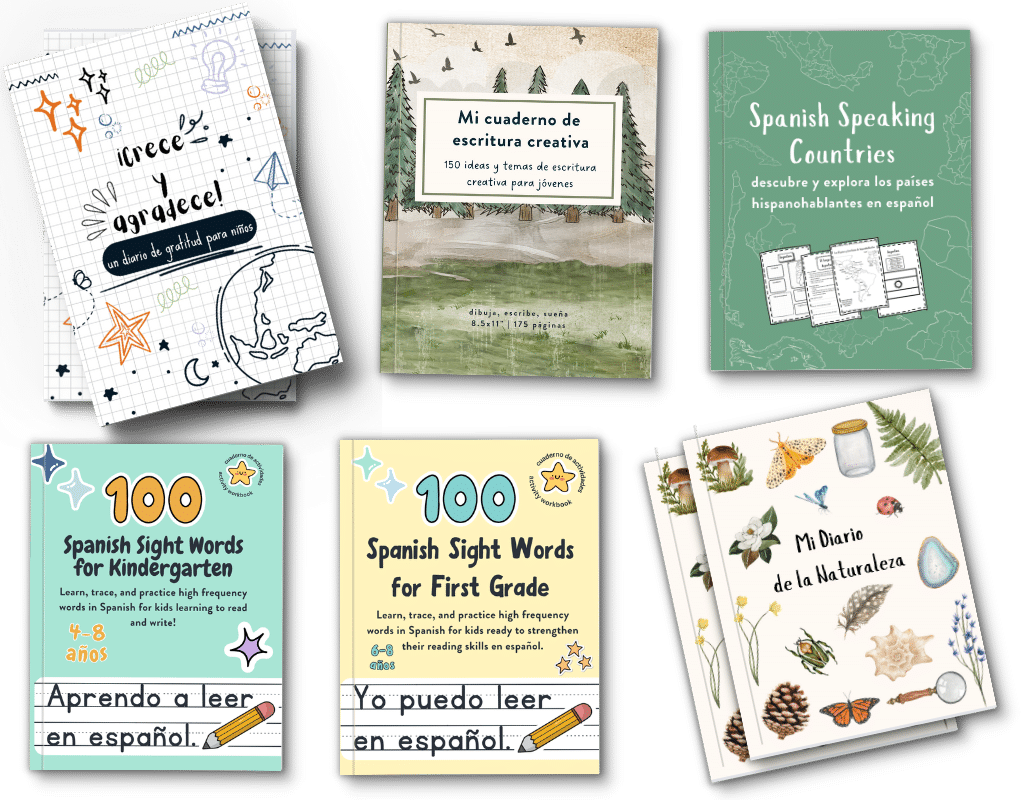
Discover the Most Adorable Spanish Terms of Endearment for Kids
In this post: Learn 40 heartwarming terms of endearment in Spanish for kids. Post may contain affiliate links.
Whether you’re a native Spanish speaker or you’re learning Spanish alongside your kids, using terms of endearment en español is a great way to make them feel special and loved. In the rich and vibrant tapestry of Spanish culture, expressing affection through words is a cherished tradition. These affectionate nicknames, or “apodos cariñosos,” can bring a smile to any child’s face, creating a warm and inviting atmosphere in your home or classroom.
From parents looking to sweetly address their little ones in Spanish to teachers wanting to foster a loving environment for their students, these Spanish terms of endearment are perfect for making children feel cherished and happy.
Table of Contents
The Importance of Terms of Endearment
Using terms of endearment is more than just a way to show affection; it’s a powerful tool for building strong emotional bonds. In Spanish-speaking cultures, these expressions are woven into the fabric of everyday life, reinforcing connections and making everyone feel valued. Whether you’re soothing a little one to sleep or praising their efforts, these endearing words can enhance your interactions and foster a loving environment.
40 Spanish Terms of Endearment for Kids
In Spanish-speaking families, it’s common to hear parents, grandparents, and even older siblings using affectionate nicknames for the younger ones. Remember this blog post has text-to-speech in Spanish! To hear any of these phrases read aloud to help you learn pronunciation, simply highlight the word/phrase and click the blue speaker.
Here are some of the most beloved terms of endearment for children used throughout the Spanish-speaking world:
- Amor (Love)
- Cariño (Dear, sweetie, honey)
- Mi vida (My life)
- Mi cielo (My sky, my heaven)
- Corazón (Heart, sweetheart)
- Bebé (Baby)
- Príncipe (Prince)
- Princesa (Princess)
- Chiquitín / Chiquitina (My little one)
- Mi niño / Mi niña (My child)
- Tesoro (Treasure)
- Mi sol (My sun/sunshine)
- Mi alma (My soul)
- Querido / Querida (Dear)
- Precioso / Preciosa (Beautiful, precious)
- Guapo / Guapa (Handsome, beautiful)
- Peque (Little one)
- Muñeco / Muñeca (Doll, sweetie)
- Mijo / Mija (My son/my daughter)
- Nene / Nena (Kid, baby)
- Campeón / Campeona (Champion)
- Ángel (Angel)
- Cachetón / Cachetona (Chubby-cheeks)
- Pollito / Pollita (Little chicken)
- Gusanito / Gusanita (Little worm)
- Frijolito (Small bean, jellybean)
- Gordito / Gordita (Chubby little one)
- Mi luz (My light)
- Conejito / Conejita (Little bunny)
- Mi príncipe / Mi princesa (My prince/princess)
- Mi ángel (My angel)
- Burbujita (Little bubble)
- Mi cielito (My little sky)
- Mi pajarito (My little bird)
- Mi amorcito (My little love)
- Cielito (Little sky)
- Solcito (Little sun)
- Pequeñín / Pequeñina (Tiny one)
- Mi dulzura (My sweetness)
- Mi estrella (My star)

Using Diminutives in Spanish
Diminutives are a fun and easy way to add an extra layer of affection to terms of endearment in Spanish. By adding -ito or -ita to a word, you can convey smallness, cuteness, and a sense of endearment. Here are more examples:
Cariño becomes Cariñito (Little darling)
- Example: “Ven aquí, cariñito.” (Come here, little darling.)
Mi vida becomes Mi vidita (My little life)
- Example: “Buenos días, mi vidita.” (Good morning, my little life.)
Amor becomes Amorcito (Little love)
- Example: “Te quiero, amorcito.” (I love you, little love.)
Mi cielo becomes Mi cielito (My little sky)
- Example: “Buenas noches, mi cielito.” (Good night, my little sky.)
Mi sol becomes Mi solcito (My little sun)
- Example: “Eres mi solcito, mi amor.” (You are my little sun, my love.)
Guapo becomes Guapito (Little handsome one)
- Example: “Ven aquí, guapito.” (Come here, little handsome one.)
Nene / Nena becomes Nenito / Nenita (Little boy / Little girl)
- Example: “¿Dónde está mi nenita?” (Where is my little girl?)
Regional Variations with Spanish Terms of Endearment
Terms of endearment can vary greatly across different Spanish-speaking regions. Here are more examples:
Mi amor is universal, but in some regions, you might hear Amorcito more frequently.
- Example: “Amorcito, ¿quieres cenar?” (Little love, do you want dinner?)
Chiquito / Chiquita (Little one) is very common in Mexico.
- Example: “Ven aquí, chiquita.” (Come here, little one.)
In Argentina, Nene / Nena (Kid, baby) is often used even for older children.
- Example: “Hola, nena, ¿cómo estás?” (Hi, kid, how are you?)
In Spain, Cielo (Heaven) is often used, but you might hear Cielito (Little heaven) more often in casual settings.
- Example: “Hola, cielito, ¿qué tal?” (Hi, little heaven, how are you?)
In Colombia, Mami / Papi (Mommy / Daddy) is used affectionately even for children.
- Example: “¿Cómo estás, mami?” (How are you, sweetie?)
In Venezuela, Gordo / Gorda (Fatty) is a common term of endearment regardless of the person’s size.
- Example: “Te extraño, gordo.” (I miss you, fatty.)
In Puerto Rico, Nene / Nena is also very common, often followed by the diminutive.
- Example: “Mi nenita preciosa.” (My precious little girl.)
By using these diminutives and understanding regional variations, you can add a personal touch to your interactions, making them even more special and endearing.
Enhance Your Spanish Learning Journey with My Spanish Homeschool Curriculum and Workbooks
Learning and using these sweet terms of endearment can be a wonderful part of your journey in mastering Spanish. All my Spanish courses and workbooks are designed to help you and your children immerse yourselves in the language in a fun and engaging way.
Whether you’re homeschooling, supplementing Spanish learning at home, teaching Spanish in a classroom, or just wanting to enrich your family’s language skills, these resources are crafted to support you every step of the way.
Incorporating Spanish terms of endearment into your daily interactions with your children is a beautiful way to express love and strengthen your bond. These affectionate nicknames not only make your kids feel cherished but also enrich their understanding of the Spanish language and culture. By using diminutives and understanding regional variations, you can add even more warmth and personality to your communication.
I hope these help bring even more joy to your Spanish learning at home!
Like this post? Share & Save it!







